
:package: athenadriver - A fully-featured AWS Athena database driver for Go
:shell: athenareader - A moneywise command line utililty to query athena in command line.
Overview
(This project is a sandbox project and the development status is STABLE.)
athenadriver is a fully-featured AWS Athena database driver for Go developed at Uber Technologies Inc.
It provides a hassle-free way of querying AWS Athena database with Go standard
library. It not only provides basic features of Athena Go SDK, but
addresses some SDK’s limitation, improves and extends it. Moreover, it also includes
advanced features like Athena workgroup and tagging creation, driver read-only mode and so on.
The PDF version of AthenaDriver document is available at :scroll:
Features
Except the basic features provided by Go database/sql like error handling, database pool and reconnection, athenadriver supports the following features out of box:
- Support multiple AWS authorization methods :link:
- Full support of Athena Basic Data Types
- Full support of Athena Advanced Type for queries with Geospatial identifiers, ML and UDFs
- Full support of ALL Athena Query Statements, including DDL, DML and UTILITY :link:
- Support newly added
INSERT INTO...VALUES - Athena workgroup and tagging support including remote workgroup creation :link:
- Go sql’s prepared statement support :link:
- Go sql’s
DB.Exec()anddb.ExecContext()support :link: - Query cancelling support :link:
- Override default query timeout limits :link:
- Mask columns with specific values :link:
- Database missing value handling :link:
- Read-Only mode - disable database write in driver level :link:
- Moneywise mode :moneybag: - print out query cost(USD) for each query
- Query with Athena Query ID(QID) - (the ultimate money saver! :money_with_wings: )
- Pseudo commands from database/sql interface:
get_driver_version,get_query_id,get_query_id_status,stop_query_id,get_workgroup,list_workgroups,update_workgroup,get_cost,get_execution_reportetc :link: - Builtin logging support with zap :link:
- Builtin metrics support with tally :link:
athenadriver can extremely simplify your code. Check athenareader out as an example and a convenient tool for your Athena query in command line.
How to set up/install/test athenadriver
Prerequisites - AWS Credentials & S3 Query Result Bucket
To be able to query AWS Athena, you need to have an AWS account at Amazon AWS’s website. To
give it a shot, a free
tier account is enough. You also need to have a pair of AWS access key ID and secret access key.
You can get it from AWS Security Credentials section of Identity and Access Management (IAM).
If you don’t have one, please create it. The following is a screenshot from my temporary free tier account:
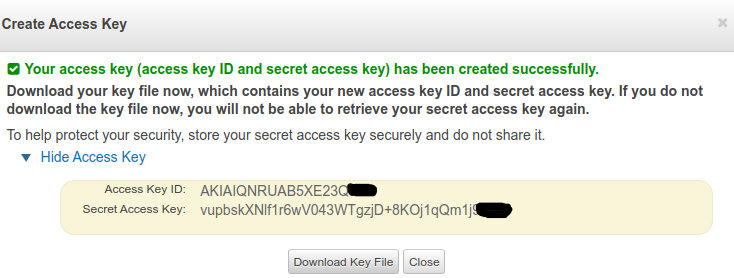
In addition to AWS credentials, you also need an s3 bucket to store query result. Just go to
AWS S3 web console page to create one.
In the examples below, the s3 bucket I use is s3://myqueryresults/.
In most cases, you need the following 4 prerequisites:
- S3 Output bucket
access key IDsecret access key- AWS region
For more details on athenadriver’s support on AWS credentials & S3 query result bucket, please refer to section
Support Multiple AWS Authorization Methods.
Installation
Before Go 1.17, go get can be used to install athenadriver:
go get -u github.com/uber/athenadriver
Starting in Go 1.17, installing executables with go get is deprecated. go install may be used instead.
go install github.com/uber/athenadriver@latest
Tests
We provide unit tests and integration tests in the codebase.
Unit Test
All the unit tests are self-contained and passed even in no-internet environment. Test coverage is 100%.
$ cd $GOPATH/src/github.com/uber/athenadriver/go
✔ /opt/share/go/path/src/github.com/uber/athenadriver [uber|✚ 1…12]
21:35 $ go test -coverprofile=coverage.out github.com/uber/athenadriver/go && \
go tool cover -func=coverage.out |grep -v 100.0%
ok github.com/uber/athenadriver/go 9.255s coverage: 100.0% of statements
Integration Test
All integration tests are under examples folder.
Please make sure all prerequisites are met so that you can run the code on your own machine.
All the code snippets in examples folder are fully tested in our machines. For example,
to run some stress and crash test, you can use examples/perf/concurrency.go. Build it first:
$cd $GOPATH/src/github.com/uber/athenadriver
$go build examples/perf/concurrency.go
Run it, wait for some output but not all, and unplug your network cable:
$./concurrency > examples/perf/concurrency.output.`date +"%Y-%m-%d-%H-%M-%S"`.log
58,13,53,54,78,96,32,48,40,11,35,31,65,61,1,73,74,22,34,49,80,5,69,37,0,79,
2020/02/09 13:49:29 error [38]RequestError: send request failed
caused by: Post https://athena.us-east-1.amazonaws.com/: dial tcp:
lookup athena.us-east-1.amazonaws.com: no such host
...
2020/02/09 13:49:29 error [89]RequestError: send request failed
caused by: Post https://athena.us-east-1.amazonaws.com/: dial tcp:
lookup athena.us-east-1.amazonaws.com: no such host
You can see RequestError is thrown out from the code. The active Athena queries failed because the network is down.
Now re-plugin your cable and wait for network coming back, you can see the program automatically reconnects to Athena, and resumes to output data correctly:
72,25,92,98,15,93,41,7,8,90,81,56,66,2,18,84,87,63,
44,45,82,99,86,3,52,76,71,16,39,67,23,12,42,17,4,
How to use athenadriver
athenadriver is very easy to use. What you need to do it to import it in your code and then use the standard Go database/sql as usual.
import athenadriver "github.com/uber/athenadriver/go"
The following are coding examples to demonstrate athenadriver’s features and how you should use athenadriver in your Go application.
Please be noted the code is for demonstration purpose only, so please follow your own coding style or best practice if necessary.
Get Started - A Simple Query
The following is the simplest example for demonstration purpose. The source code is available at dml_select_simple.go.
package main
import (
"database/sql"
drv "github.com/uber/athenadriver/go"
)
func main() {
// Step 1. Set AWS Credential in Driver Config.
conf, _ := drv.NewDefaultConfig("s3://myqueryresults/",
"us-east-2", "DummyAccessID", "DummySecretAccessKey")
// Step 2. Open Connection.
db, _ := sql.Open(drv.DriverName, conf.Stringify())
// Step 3. Query and print results
var url string
_ = db.QueryRow("SELECT url from sampledb.elb_logs limit 1").Scan(&url)
println(url)
}
To make it work for you, please replace OutputBucket, Region, AccessID and
SecretAccessKey with your own values. sampledb is provided by Amazon so you don’t have to worry about it.
To Build it:
$ go build examples/query/dml_select_simple.go
Run it and you can see output like:
$ ./dml_select_simple
https://www.example.com/articles/553
Support Multiple AWS Authentication Methods
athenadriver uses access keys(Access Key ID and Secret Access Key) to sign programmatic requests to AWS.
When if the AWS_SDK_LOAD_CONFIG environment variable was set, athenadriver uses Shared Config, respects AWS CLI Configuration and Credential File Settings and gives it even higher priority over the values set in athenadriver.Config.
Use AWS CLI Config For Authentication
When environment variable AWS_SDK_LOAD_CONFIG is set, it will read aws_access_key_id(AccessID) and aws_secret_access_key(SecretAccessKey)
from ~/.aws/credentials, region from ~/.aws/config. For details about ~/.aws/credentials and ~/.aws/config, please check here.
But you still need to specify correct OutputBucket in athenadriver.Config because it is not in the AWS client config.
OutputBucket is critical in Athena. Even if you have a default value set in Athena web console, you must pass one programmatically or you will get error:
No output location provided. An output location is required either through the Workgroup result configuration setting or as an API input.
The sample code below enforces AWS_SDK_LOAD_CONFIG is set, so athenadriver’s AWS Session will be created from the configuration values from the shared config (~/.aws/config) and shared credentials (~/.aws/credentials) files.
Even if we pass all dummy values as parameters in NewDefaultConfig() except OutputBucket, they are overridden by
the values in AWS CLI config files, so it doesn’t really matter.
// To use AWS CLI's Config for authentication
func useAWSCLIConfigForAuth() {
os.Setenv("AWS_SDK_LOAD_CONFIG", "1")
// 1. Set AWS Credential in Driver Config.
conf, err := drv.NewDefaultConfig(secret.OutputBucketProd, drv.DummyRegion,
drv.DummyAccessID, drv.DummySecretAccessKey)
if err != nil {
return
}
// 2. Open Connection.
db, _ := sql.Open(drv.DriverName, conf.Stringify())
// 3. Query and print results
var i int
_ = db.QueryRow("SELECT 456").Scan(&i)
println("with AWS CLI Config:", i)
os.Unsetenv("AWS_SDK_LOAD_CONFIG")
}
If your AWS CLI setting is valid like mine, this function should output:
with AWS CLI Config: 456
The above authentication method also works for querying Athena in AWS Lambda. In lambda, you don’t have to provide access ID, key and region, and you don’t need AWS CLI config files either. You just need to specify the correct output bucket. Please check the AWS Lambda Go same code here.
Use athenadriver Config For Authentication
When environment variable AWS_SDK_LOAD_CONFIG is NOT set, you may explicitly define credentials by passing valid (NOT dummy) accessID, secretAccessKey, region, and outputBucket into athenadriver.NewDefaultConfig().
The sample code below ensure AWS_SDK_LOAD_CONFIG is not set, then pass four valid parameters into NewDefaultConfig():
// To use athenadriver's Config for authentication
func useAthenaDriverConfigForAuth() {
os.Unsetenv("AWS_SDK_LOAD_CONFIG")
// 1. Set AWS Credential in Driver Config.
conf, err := drv.NewDefaultConfig(secret.OutputBucketDev, secret.Region,
secret.AccessID, secret.SecretAccessKey)
if err != nil {
return
}
// 2. Open Connection.
db, _ := sql.Open(drv.DriverName, conf.Stringify())
// 3. Query and print results
var i int
_ = db.QueryRow("SELECT 123").Scan(&i)
println("with AthenaDriver Config:", i)
}
The sample output:
with AthenaDriver Config: 123
The full code is here at examples/auth.go.
Use AWS SDK Default Credentials Resolution for Authentication
If environment variable AWS_SDK_LOAD_CONFIG is NOT set and credentials are not supplied in the athenadriver configuration, the AWS SDK will look up credentials using its default methodology described here: https://docs.aws.amazon.com/sdk-for-go/v1/developer-guide/configuring-sdk.html#specifying-credentials.
Region and OutputBucket bucket still need to be explictly defined.
The sample code below ensures AWS_SDK_LOAD_CONFIG is not set, then creates a athenadriver config with OutputBucket and Region values set.
// To use AWS SDK Default Credentials
func useAthenaDriverConfigForAuth() {
os.Unsetenv("AWS_SDK_LOAD_CONFIG")
// 1. Set OutputBucket and Region in Driver Config.
conf := drv.NewNoOpsConfig()
conf.SetOutputBucket(secret.OutputBucketDev)
conf.SetRegion(secret.Region)
// 2. Open Connection.
db, _ := sql.Open(drv.DriverName, conf.Stringify())
// 3. Query and print results
var i int
_ = db.QueryRow("SELECT 123").Scan(&i)
println("with AthenaDriver Config:", i)
}
The sample output:
with AthenaDriver Config: 123
Full Support of All Data Types
As we said, athenadriver supports all Athena data types.
In the following sample code, we use an SQL statement to SELECT som simple data of all the advanced types and then print them out.
package main
import (
"context"
"database/sql"
drv "github.com/uber/athenadriver/go"
)
func main() {
// 1. Set AWS Credential in Driver Config.
conf, err := drv.NewDefaultConfig("s3://myqueryresults/",
"us-east-2", "DummyAccessID", "DummySecretAccessKey")
if err != nil {
panic(err)
}
// 2. Open Connection.
dsn := conf.Stringify()
db, _ := sql.Open(drv.DriverName, dsn)
// 3. Query and print results
query := "SELECT JSON '\"Hello Athena\"', " +
"ST_POINT(-74.006801, 40.70522), " +
"ROW(1, 2.0), INTERVAL '2' DAY, " +
"INTERVAL '3' MONTH, " +
"TIME '01:02:03.456', " +
"TIME '01:02:03.456 America/Los_Angeles', " +
"TIMESTAMP '2001-08-22 03:04:05.321 America/Los_Angeles';"
rows, err := db.Query(query)
if err != nil {
panic(err)
}
defer rows.Close()
println(drv.ColsRowsToCSV(rows))
}
Sample output:
"Hello Athena",00 00 00 00 01 01 00 00 00 20 25 76 6d 6f 80 52 c0 18 3e 22 a6 44 5a 44 40,
{field0=1, field1=2.0},2 00:00:00.000,0-3,0000-01-01T01:02:03.456-07:52,
0000-01-01T01:02:03.456-07:52,2001-08-22T03:04:05.321-07:00
we can see athenadriver can handle all these advanced types correctly.
Query With Workgroup and Tag
athenadriver supports workgroup and tagging features of Athena. When you query Athena, you can specify the
workgroup and tags attached with your query. Resource/cost tagging are based on workgroup. If the workgroup doesn’t
exist , by default it will be created programmatically.
If you want to disable programmatically creating workgroup and tags, you need to explicitly call:
Config.SetWGRemoteCreationAllowed(false)
In this case, you need to make sure the workgroup you specifies must exist, or you will get error. An example is like below:
package main
import (
"database/sql"
"log"
drv "github.com/uber/athenadriver/go"
)
func main() {
// 1. Set AWS Credential in Driver Config.
conf, _ := drv.NewDefaultConfig("s3://myqueryresults/",
"us-east-2", "DummyAccessID", "DummySecretAccessKey")
wgTags := drv.NewWGTags()
wgTags.AddTag("Uber User", "henry.wu")
wgTags.AddTag("Uber ID", "123456")
wgTags.AddTag("Uber Role", "SDE")
// Specify that workgroup `henry_wu` is used for the following query
wg := drv.NewWG("henry_wu", nil, wgTags)
conf.SetWorkGroup(wg)
// comment out the line below to allow remote workgroup creation and
// the query will be successful!!!
conf.SetWGRemoteCreationAllowed(false)
// 2. Open Connection.
dsn := conf.Stringify()
db, _ := sql.Open(drv.DriverName, dsn)
// 3. Query and print results
rows, err := db.Query("select url from sampledb.elb_logs limit 3")
if err != nil {
log.Fatal(err)
return
}
defer rows.Close()
var url string
for rows.Next() {
if err := rows.Scan(&url); err != nil {
log.Fatal(err)
}
println(url)
}
}
But I don’t have a workgroup named henry_wu in AWS Athena, so I got sample output:
2020/01/20 15:29:52 Workgroup henry_wu doesn't exist and workgroup remote creation
is disabled.
After commenting out conf.SetWGRemoteCreationAllowed(false) at line 27, the output becomes:
https://www.example.com/articles/553
http://www.example.com/images/501
https://www.example.com/images/183
and I can see a new workgroup named henry_wu is created in AWS Athena console: https://us-east-2.console.aws
.amazon.com/athena/workgroups/home
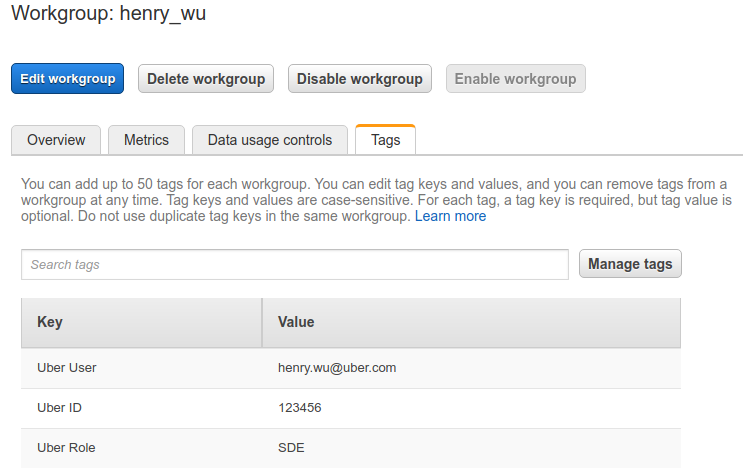
Prepared Statement Support for Athena DB
Athena doesn’t support prepared statement originally. However, it could be very helpful in some
scenarios like where part of the query is from user input. athenadriver supports prepared statements
to help you to deal with those scenarios. An example is as follows:
package main
import (
"database/sql"
drv "github.com/uber/athenadriver/go"
)
func main() {
// 1. Set AWS Credential in Driver Config.
conf, _ := drv.NewDefaultConfig("s3://myqueryresults/",
"us-east-2", "DummyAccessID", "DummySecretAccessKey")
// 2. Open Connection.
db, _ := sql.Open(drv.DriverName, conf.Stringify())
// 3. Prepared Statement
statement, err := db.Prepare("CREATE TABLE sampledb.urls AS " +
"SELECT url FROM sampledb.elb_logs where request_ip=? limit ?")
if err != nil {
panic(err)
}
// 4. Execute prepared Statement
if result, e := statement.Exec("244.157.42.179", 2); e == nil {
if rowsAffected, err := result.RowsAffected(); err == nil {
println(rowsAffected)
}
}
}
Sample output:
2
Parameterized Queries
Athena supports parameterized queries: https://docs.aws.amazon.com/athena/latest/ug/querying-with-prepared-statements.html. Parameterized queries allow for re-running the same query with different parameter values at runtime, and help guard against SQL injection attacks. This is especially useful if some of your parameter values are derived from user input.
To use parameterized queries, use ? as placeholders in the query you pass to DB.Query() or DB.Exec().
For each parameter, pass in arguments in the order they should replace ?. For strings and byte slice arguments, use
drv.FormatString() and drv.FormatBytes() to escape special characters and format per Athena’s requirements.
Example:
query := "SELECT request_timestamp, elb_name FROM sampledb.elb_logs WHERE url=? limit 1"
args := []any{drv.FormatString("https://www.example.com/jobs/878")}
rows, err := db.Query(query, args)
if err != nil {
return
}
println(drv.ColsRowsToCSV(rows))
Sample Output:
request_timestamp,elb_name
2015-01-06T04:03:01.351843Z,elb_demo_006
DB.Exec() and DB.ExecContext()
According to Go source code, DB.Exec() and DB.ExecContext() execute a query that doesn’t return rows,
such as an INSERT or UPDATE.
It’s true that you can use DB.Exec() and DB.Query() interchangeably to execute the same SQL statements.
However, the two methods are for different use cases and return different types of results. According to Go database/sql library, the result
returned from DB.Exec() can tell you how many rows were affected by the query and the last inserted ID for INSERT INTO statement,
which is always -1 for Athena because auto-increment primary key feature is not supported by Athena.
In contrast, DB.Query() will return a sql.Rows object which includes all columns and rows details.
When the only concern is if the execution is successful or not, DB.Exec() is
preferred to DB.Query() . The best coding practice is:
if _, err := DB.Exec(`<SQL_STATEMENT>`); err != nil {
log_or_panic(err)
}
In cases of INSERT INTO, CTAG and CVAS, you may want to know when the execution
is successful how many rows are affected by your query. Then you can use result.RowsAffected() as
demonstrated in the following example:
package main
import (
"context"
"database/sql"
drv "github.com/uber/athenadriver/go"
)
func main() {
// 1. Set AWS Credential in Driver Config.
var conf *drv.Config
var err error
if conf, err = drv.NewDefaultConfig("s3://myqueryresults/",
"us-east-2", "DummyAccessID", "DummySecretAccessKey"); err != nil {
panic(err)
}
// 2. Open Connection.
db, _ := sql.Open(drv.DriverName, conf.Stringify())
// 3. Execute and print results
if _, err = db.ExecContext(context.Background(),
"DROP TABLE IF EXISTS sampledb.urls"); err != nil {
panic(err)
}
var result sql.Result
if result, err = db.Exec("CREATE TABLE sampledb.urls AS "+
"SELECT url FROM sampledb.elb_logs where request_ip=? limit ?",
"244.157.42.179", 1); err != nil {
panic(err)
}
println(result.RowsAffected())
if result, err = db.Exec("INSERT INTO sampledb.urls VALUES (?),(?),(?)",
"abc", "efg", "xyz"); err != nil {
panic(err)
}
println(result.RowsAffected())
println(result.LastInsertId()) // not supported by Athena
}
Sample output:
1
3
Mask Columns with Specific Values
Sometimes, database contains sensitive information and you may need to mask columns with specific values. If you don’t want to display some columns, you can mask them by calling:
Config.SetMaskedColumnValue("columnName", "maskValue")
For example, if you want to mask all rows of column password, you can specify:
Config.SetMaskedColumnValue("password", "xxx")
Then all the passwords will be displayed as xxx in the query result set. The following is an example to
mask column url in the result set.
package main
import (
"database/sql"
"log"
drv "github.com/uber/athenadriver/go"
)
func main() {
// 1. Set AWS Credential in Driver Config.
conf, _ := drv.NewDefaultConfig("s3://myqueryresults/",
"us-east-2", "DummyAccessID", "DummySecretAccessKey")
conf.SetMaskedColumnValue("url", "xxx")
// 2. Open Connection.
dsn := conf.Stringify()
db, _ := sql.Open(drv.DriverName, dsn)
// 3. Query and print results
rows, err := db.Query("select request_timestamp, url from " +
"sampledb.elb_logs limit 3")
if err != nil {
log.Fatal(err)
return
}
defer rows.Close()
var requestTimestamp string
var url string
for rows.Next() {
if err := rows.Scan(&requestTimestamp, &url); err != nil {
log.Fatal(err)
}
println(requestTimestamp + "," + url)
}
}
Sample Output:
2015-01-03T12:00:00.516940Z,xxx
2015-01-03T12:00:00.902953Z,xxx
2015-01-03T12:00:01.206255Z,xxx
Query Cancellation
AWS Athena is priced upon the data size it scanned. To save money, athenadriver supports query cancellation. In
the following example, the query is cancelled if it is not complete after 2 seconds.
package main
import (
"context"
"database/sql"
"log"
"time"
drv "github.com/uber/athenadriver/go"
)
func main() {
// 1. Set AWS Credential in Driver Config.
conf, _ := drv.NewDefaultConfig("s3://myqueryresults/",
"us-east-2", "DummyAccessID", "DummySecretAccessKey")
// 2. Open Connection.
dsn := conf.Stringify()
db, _ := sql.Open(drv.DriverName, dsn)
// 3. Query cancellation after 2 seconds
ctx, _ := context.WithTimeout(context.Background(), 2*time.Second)
rows, err := db.QueryContext(ctx, "select count(*) from sampledb.elb_logs")
if err != nil {
log.Fatal(err)
return
}
defer rows.Close()
var requestTimestamp string
var url string
for rows.Next() {
if err := rows.Scan(&requestTimestamp, &url); err != nil {
log.Fatal(err)
}
println(requestTimestamp + "," + url)
}
}
Sample Output:
2020/01/20 15:28:35 context deadline exceeded
Overriding Athena Service Limits for Query Timeout
This library assumes default Athena service limits for DDL and DML query timeouts, as can be found in athenadriver/go/constants.go.
If you’ve increased your service limits, for example via the Athena Service Quotas console,
you can override them on your Config.
Here’s the same example found at Query Cancellation, but with an increased query timeout.
package main
import (
"context"
"database/sql"
"log"
"time"
drv "github.com/uber/athenadriver/go"
)
func main() {
// 1. Set AWS Credential in Driver Config.
conf, _ := drv.NewDefaultConfig("s3://myqueryresults/",
"us-east-2", "DummyAccessID", "DummySecretAccessKey")
// 2. Override the DML query timeout to 60 minutes (3600 seconds).
serviceLimitOverride := drv.NewServiceLimitOverride()
serviceLimitOverride.SetDMLQueryTimeout(3600)
conf.SetServiceLimitOverride(*serviceLimitOverride)
// 3. Open Connection.
dsn := conf.Stringify()
db, _ := sql.Open(drv.DriverName, dsn)
// 4. Run the query.
rows, err := db.QueryContext(context.Background(), "select count(*) from sampledb.elb_logs")
if err != nil {
log.Fatal(err)
return
}
defer rows.Close()
var requestTimestamp string
var url string
for rows.Next() {
if err := rows.Scan(&requestTimestamp, &url); err != nil {
log.Fatal(err)
}
println(requestTimestamp + "," + url)
}
}
Missing Value Handling
It is common to have missing values in S3 file, or Athena DB. When this happens, you can specify if you want to use
empty string, default data, or nil as the missing value, whichever is better to facilitate your data processing or ETL job. The default data for Athena column type are defined as below:
func (r *Rows) getDefaultValueForColumnType(athenaType string) interface{} {
switch athenaType {
case "tinyint", "smallint", "integer", "bigint":
return 0
case "boolean":
return false
case "float", "double", "real":
return 0.0
case "date", "time", "time with time zone", "timestamp",
"timestamp with time zone":
return time.Time{}
default:
return ""
}
}
By default, we use empty string to replace missing values and empty string is preferred to default data, or nil. To use
default data, you have to explicitly call:
Config.SetMissingAsEmptyString(false)
Config.SetMissingAsDefault(true)
If you need to use nil as missing value, you can call:
Config.SetMissingAsEmptyString(false)
Config.SetMissingAsDefault(false)
Config.SetMissingAsNil(true)
But if you are strict with your data integrity and want an error raised when data are missing, you can set all three of them to false.
Read-Only Mode
When read-only mode is enabled in athenadriver, it only allows retrieving information from Athena database.
Any writing and modification to the database will raise an error. This is useful in some cases. By default, read-only mode
is disabled. To enable it, you need to explicitly call:
Config.SetReadOnly(true)
The following is one example. It enables read-only mode in line 19, but tries to create a new table with CTAS statement. It ends up with raising an error.
package main
import (
"context"
"database/sql"
"log"
drv "github.com/uber/athenadriver/go"
)
func main() {
// 1. Set AWS Credential in Driver Config.
conf, _ := drv.NewDefaultConfig("s3://myqueryresults/",
"us-east-2", "DummyAccessID", "DummySecretAccessKey")
conf.SetReadOnly(true)
// 2. Open Connection.
dsn := conf.Stringify()
db, _ := sql.Open(drv.DriverName, dsn)
// 3. Create Table with CTAS statement
rows, err := db.QueryContext(context.Background(),
"CREATE TABLE sampledb.elb_logs_new AS " +
"SELECT * FROM sampledb.elb_logs limit 10;")
if err != nil {
log.Fatal(err)
return
}
defer rows.Close()
}
Sample Output:
2020/01/26 01:10:28 writing to Athena database is disallowed in read-only mode
Pseudo Commands
athenadriver provides pseudo command to support some special use cases beyond Go’s standard database/sql framework.
One sample use case is Asynchronous Query Support.
pseudo command is a special prefix string you can put in db.QueryContext or db.QueryRow or db.ExecuteContext etc.
It is easier to explain with an example like pc_get_query_id.go.
package main
import (
"database/sql"
"os"
secret "github.com/uber/athenadriver/examples/constants"
drv "github.com/uber/athenadriver/go"
)
func main() {
// 1. Set AWS Credential in Driver Config.
os.Setenv("AWS_SDK_LOAD_CONFIG", "1")
conf, err := drv.NewDefaultConfig(secret.OutputBucket, secret.Region, secret.AccessID, secret.SecretAccessKey)
conf.SetLogging(true)
if err != nil {
panic(err)
return
}
// 2. Open Connection.
dsn := conf.Stringify()
db, _ := sql.Open(drv.DriverName, dsn)
// 3. Query with pseudo command `pc:get_query_id`
var qid string
_ = db.QueryRow("pc:get_query_id select url from sampledb.elb_logs limit 2").Scan(&qid)
println("Query ID: ", qid)
}
In pc_get_query_id.go, we only want to get the Query ID of the SQL statement, so we
just to add pc:get_query_id before the sql statement. So the final string we pass to db.QueryRow is pc:get_query_id select url from sampledb.elb_logs limit 2. The return value is one row with an Athena Query ID inside. A sample Output is:
Query ID: c89088ab-595d-4ee6-a9ce-73b55aeb8953
Now we support three pseudo commands: get_query_id, get_query_id_status, stop_query_id.
The syntax is pc:pseudo_command parameter.
get_query_id
pc:get_query_id SQL_STATEMENT - Will return Query ID of the SQL_STATEMENT, no matter request fails or succeeds. Example: pc_get_query_id.go.
get_query_id_status
pc:get_query_id_status Query_ID - Return status of the Query ID. Example: pc_get_query_id_status.go.
stop_query_id
pc:stop_query_id Query_ID - To stop the Query corresponding the Query ID. If there is no error, a one row string with OK will be returned. Example: pc_stop_query_id.go.
get_driver_version
pc:get_driver_version - To return the version of athenadriver. Example: pc_get_driver_version.go.
Enable Driver Logging
You can enable driver logging to help you to debug, monitoring and know more details about the running system. Logging is by default enabled and implemented as a no-op Logger. You need to pass a workable logger to make it work. If you don’t want to log at all, you need to explicitly call:
Config.SetLogging(false)
The following example is to pass in a zap Production logger.
package main
import (
"context"
"database/sql"
"log"
"time"
"go.uber.org/zap"
drv "github.com/uber/athenadriver/go"
)
func main() {
// 1. Set AWS Credential in Driver Config.
conf, _ := drv.NewDefaultConfig("s3://query-results-bucket-test/",
"us-east-2",
"dummy-to-be-replaced",
"dummy-to-be-replaced")
// 2. Open Connection.
dsn := conf.Stringify()
db, _ := sql.Open(drv.DBDriverName, dsn)
logger, _ := zap.NewProduction()
defer logger.Sync()
// 3. Query cancellation after 2 seconds
ctx, _ := context.WithTimeout(context.Background(), 2*time.Second)
ctx = context.WithValue(ctx, drv.LoggerKey, logger)
rows, err := db.QueryContext(ctx, "select count(*) from sampledb.elb_logs")
if err != nil {
log.Fatal(err)
return
}
defer rows.Close()
}
Sample Output:
{"level":"warn","ts":1579556666.3372262,"caller":"athenadriver/observability.go:72","msg":"query canceled","resp.QueryExecutionId":
"ef4f3f09-a480-445c-84ad-96ecd97a8e90"}
2020/01/20 13:44:26 context deadline exceeded
Enable Metrics
athenadriver supports tally metrics reporting builtin. Metrics reporting is by default enabled but implemented as a
no-op Scope. You need to pass a workable scope to make it work. If you don’t want metrics at all, you need to explicitly call:
Config.SetMetrics(false)
The following example is to pass in a scope with statsd reporter.
package main
import (
"context"
"database/sql"
"io"
"log"
"time"
"github.com/cactus/go-statsd-client/statsd"
tallystatsd "github.com/uber-go/tally/v4/statsd"
drv "github.com/uber/athenadriver/go"
"github.com/uber-go/tally/v4"
)
func newScope() (tally.Scope, io.Closer) {
statter, _ := statsd.NewBufferedClient("127.0.0.1:8125", "stats", 100*time.Millisecond, 1440)
reporter := tallystatsd.NewReporter(statter, tallystatsd.Options{
SampleRate: 1.0,
})
scope, closer := tally.NewRootScope(tally.ScopeOptions{
Prefix: "my_test_metrics_service",
Tags: map[string]string{},
Reporter: reporter,
}, time.Second)
return scope, closer
}
func main() {
// 1. Set AWS Credential in Driver Config.
conf, _ := drv.NewDefaultConfig("s3://query-results-bucket-test/",
"us-east-2", "dummy-to-be-replaced", "dummy-to-be-replaced")
// 2. Open Connection.
dsn := conf.Stringify()
db, _ := sql.Open(drv.DBDriverName, dsn)
// 3. Query cancellation after 2 seconds
// Create tally scope
scope, _ := newScope()
// Create context and attach tally scope with context
ctx, _ := context.WithTimeout(context.Background(), 5*time.Second)
ctx = context.WithValue(ctx, drv.MetricsKey, scope)
rows, err := db.QueryContext(ctx, "select count(*) from sampledb.elb_logs")
if err != nil {
log.Fatal(err)
return
}
defer rows.Close()
}
Run netcat(nc) in another terminal to listen at port 8125 with command:
nc 8125 -l -u
Then run the code above, you can see the underlying details of driver are reported as metrics like below:
$ nc 8125 -l -u
stats.my_test_metrics_service.awsathena.connector.connect:0.140147|ms
stats.my_test_metrics_service.awsathena.query.workgroup:0.000607|ms
stats.my_test_metrics_service.awsathena.query.startqueryexecution:1191.644566|ms
stats.my_test_metrics_service.awsathena.query.queryexecutionstatesucceeded:3320.820154|ms
Limitations of Go/Athena SDK’s and athenadriver’s Solution
Column number mismatch in GetQueryResults of Athena Go SDK
ColumnInfo has more number of cloumns than Rows[0].Data
Affected Statements: DESCRIBE TABLE/VIEW, SHOW SCHEMA/TABLE/…
- Sample Query:
DESC sampledb.elb_logs
- Analysis:
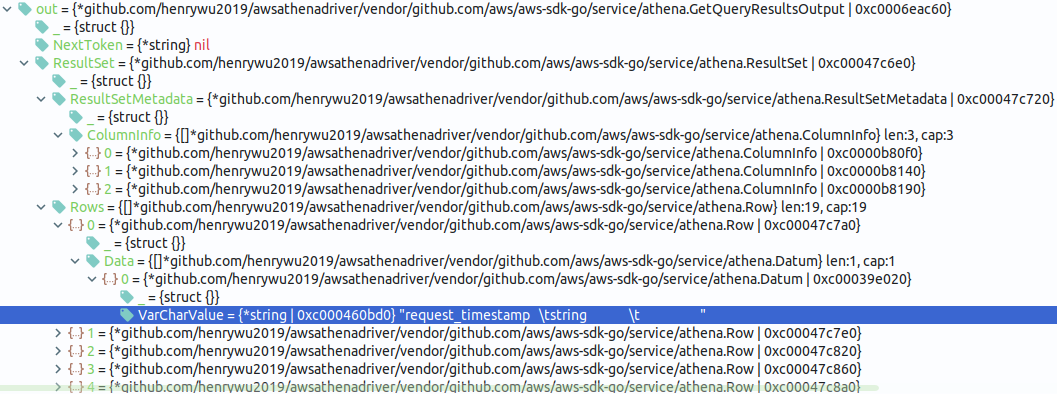
We can see there are 3 columns according to ColumnInfo under ResultSetMetadata. But in the first row Rows[0], we see there is only 1 field: "elb_name \tstring \t ". I would imagine there could have been 3 items in the Data[0], but somehow the code author doesn’t split it with tab(\t), so it ends up with only 1 item. The same issue happens for SHOW statement.
For more sample code, please check util_desc_table.go, util_desc_view.go, and util_show.go.
athenadriver’s Solution:
athenadriver fixes this issue by splitting Rows[0].Data[0] string with tab, and replace the original row with a new row which has the same number of data with columns.
ColumnInfo has cloumns but Rows are empty
Affected Statements:
CTAS, CVAS, INSERT INTO
Sample Query:
CREATE TABLE sampledb.elb_logs_copy WITH (
format = 'TEXTFILE',
external_location = 's3://external-location-test/elb_logs_copy',
partitioned_by = ARRAY['ssl_protocol'])
AS SELECT * FROM sampledb.elb_logs
Analysis:
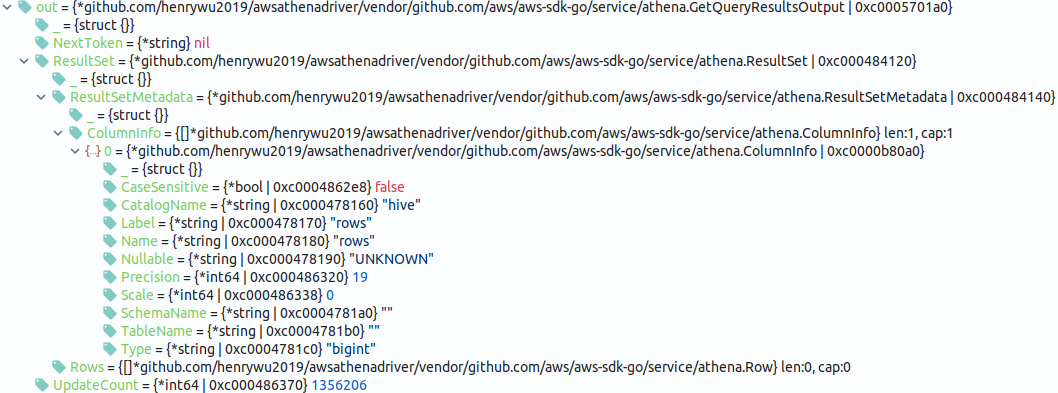
In the above CTAS statement, we see there is one column of type bigint named
"rows" in the resultset, but ResultSet.Rows is empty. Since there is no
row, that one column doesn’t make sense, or at least is confusing. The same
issue happens for INSERT INTO statement.
athenadriver’s Solution:
Because this issue happens only in statements CTAS, CVAS, and INSERT INTO
, where UpdateCount is always valid and is the only meaningful information
returned from Athena, athenadriver sets UpdateCount as the value of
the returned row.
For more sample code, please check ddl_ctas.go, ddl_cvas.go, and dml_insert_into.go.
Type Loss for map, struct, array etc
One of Athena Go SDK’s limitations is the type information could be lost after querying. I think there are two reasons for this type information loss.
The first reason is Athena SDK doesn’t provide the full type information for complex type data. It assumes the application developers know the data schema and should take the responsibility of data serialization.
To dig into the code, all query results are stored in data structure
ResultSet.
From the UML class graph of ResultSet below, we can see the type
information are stored in ColumnInfo’s pointer to string variable Type,
which is only a type name of data type, not containing any type metadata.
For example, querying a map of string->boolean will return the type name map,
but you cannot find the information string->boolean in the ResultSet. For simple type like integer,
boolean or string, it is sufficient to serialize them to Go type, but for more complex types like array,
struct, map or nested types, the type information is lost here.
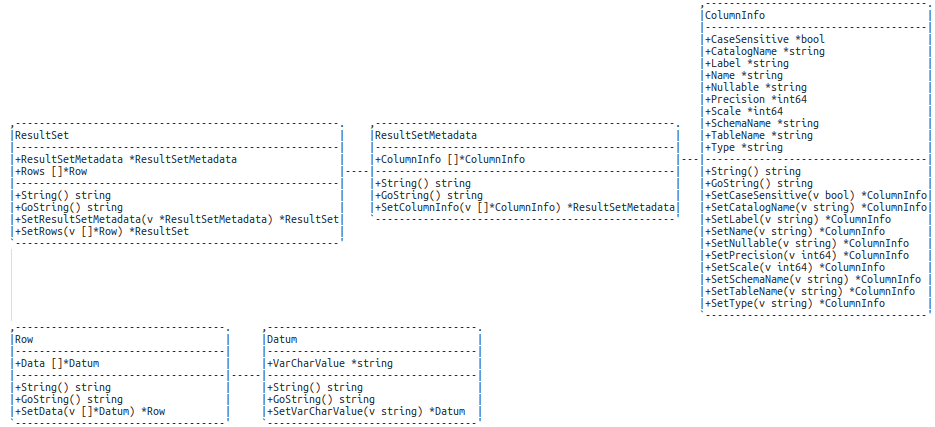
The second reason is the difference between Athena data type and Go data type.
Some Athena builtin data type like Row, DECIMAL(p, s), varbinary, interval year to month
are not supported in Go standard library. Therefore, there is no way to serialize them in driver level.
athenadriver’s Solution:
For data types: array, map, json, char, varchar, varbinary, row, string, binary, struct, interval year to month, interval day to second, decimal, athenadriver returns the string representation of the data. The developers can firstly retrieve the string representation, and then serialize to user defined type on their own.
For time and date types: date, time, time with time zone, timestamp, timestamp with time zone, athenadriver returns Go’s time.Time.
Some sample code are available at dml_select_array.go, dml_select_map.go, dml_select_time.go.
FAQ
The following is a collection of questions from our software developers and data scientists.
Does athenadriver support database reconnection?
Yes. database/sql maintains a connection pool internally and handles connection pooling, reconnecting, and retry logic for you.
One pitfall of writing Go sql application is cluttering the code with error-handling and retry.
I tested in my application with athenadriver by turning off and on Wifi and VPN, it works very well with database reconnection.
Does athenadriver support batched query?
No. athenadriver is an implementation of sql.driver in Go database/sql, where there is no batch query support.
There might be some workaround for some specific case though. For instance,
if you want to insert many rows, you can use db.Exec
by replacing multiple inserts with one insert and multiple VALUES.
How to use athenadriver to get total row number of result set?
You have to use rows.Next() to iterate all rows and use a counter to get row number. It is because Go database/sql was designed in a streaming query way with big data considered. That is why it only supports using Next() to iterate. So there is no way for random access of row. In Athena case, we only have random access of all the rows within one result page as the picture shown below:

But due to encapsulation, more sepcifically the rowsi is private, we
cannot access it directly like when we using Athena Go SDK. We have to use Next() to access it one by one.
Is there any way to randomly access row with athenadriver?
No. The reason is the same as answer to the previous question.
Does athenadriver support getting the rows affected by my query?
To put it simple, YES. But there is some limitation and best practice to follow.
The recommended way is to use DB.Exec() to get it. Please refer to :link: .
You can get it with DB.Query() too. In the returned ResultSet, there is
an UpdateCount member variable. If the query is one of CTAS, CVAS and INSERT INTO, UpdateCount will contain meaningful value. The result will be of a one row and one column. The column name is rows, and the row is an int, which is exactly UpdateCount. I would suggest to use QueryRow or QueryRowContext since it is a one-row result. By the way, the document for GetQueryResults seems not very accurate.

In practice, not only CTAS statement but also CVAS and INSERT INTO will make a meaningful UpdateCount.
Development Status: Stable
All APIs are finalized, and no breaking changes will be made in the 1.x series of releases.
This library is now at version 1 and follows SemVer strictly.
Contributing
We encourage and support an active, healthy community of contributors — including you! Details are in the contribution guide and the code of conduct. The athenadriver maintainers keep an eye on issues and pull requests, but you can also report any negative conduct to oss-conduct@uber.com. That email list is a private, safe space; even the athenadriver maintainers don’t have access, so don’t hesitate to hold us to a high standard.
athenadriver UML Class Diagram
For the contributors, the following is athenadriver Package’s UML Class Diagram which may help you to
understand the code. You can also check the reference section below for some useful materials.
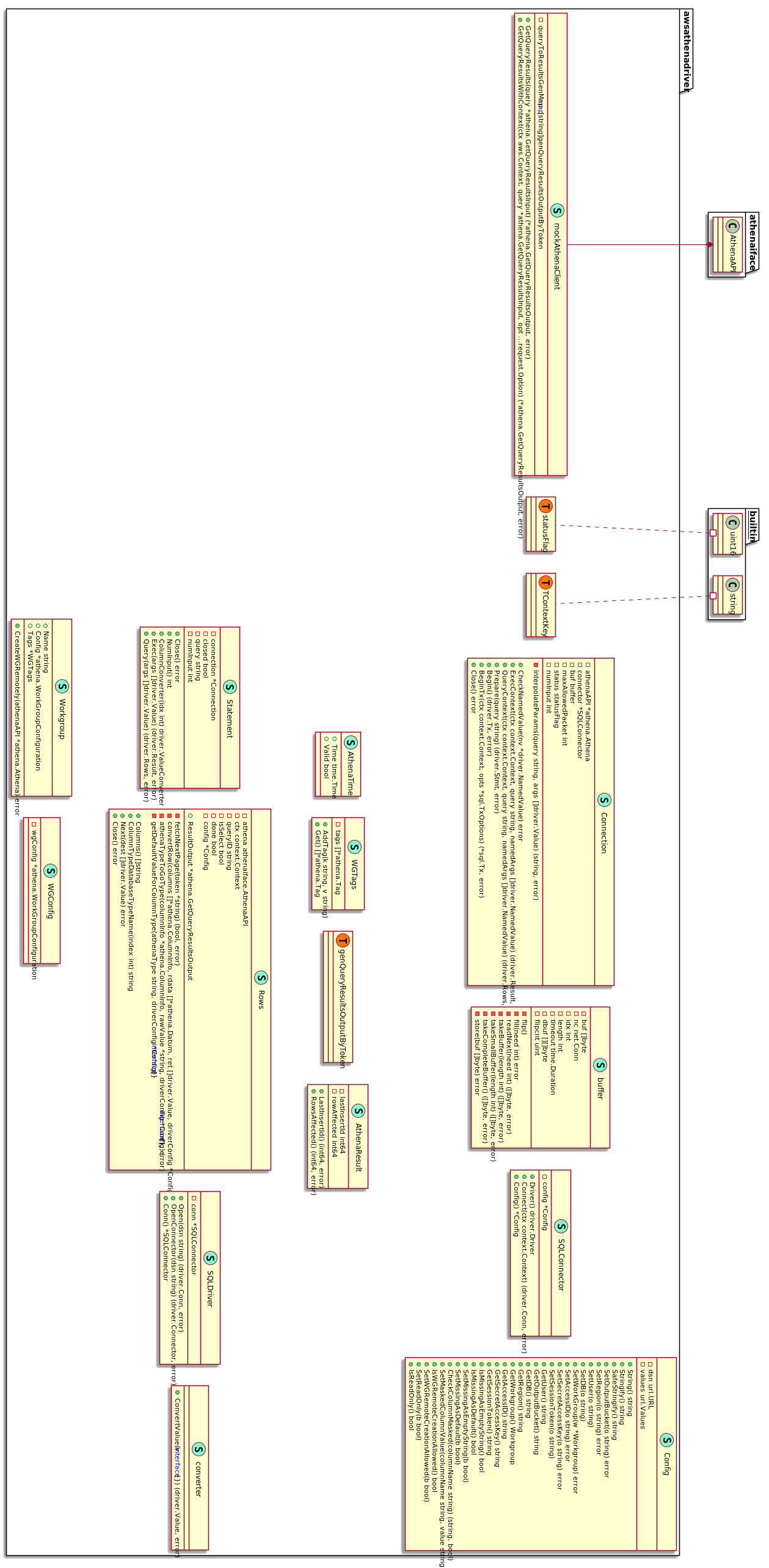
Reference
- Amazon Athena User Guide
- Amazon Athena API Reference - Describes the Athena API operations in detail.
- Amazon Athena Go Doc
- Data type mappings that the JDBC driver supports between Athena, JDBC, and Java
- Service Quotas
- Go sql connection pool
- Common Pitfalls When Using database/sql in Go
- Implement Sql Database Driver in 100 Lines of Go
ChangeLog
v1.1.15 - Merge community contribution (March 03, 2024)
- Rename S3 bucket in test code (@jonathanbaker7 Jonathan Baker, @henrywoo)
- Make poll interval configurable (@keshav-dataco Keshav Murthy)
- Add microseconds and nanosecond time format parsing (@Sly1024 Szilveszter Safar)
- Add option to return missing values as nil (@kevinwcyu Kevin Yu)
v1.1.14 - Merge community contribution (August 19, 2022)
- Adding default AWS SDK credential resolution to connector (@dfreiman-hbo, Dan Freiman)
- Bump go-pretty version to most recent version (@nyergler, Nathan Yergler)
- Expose DriverTracer factory functions (@andresmgot, Andres Martinez Gotor)
- Add support to go 1.17+ (@henrywoo, Henry Fuheng Wu)
- README cleanup (@henrywoo, Henry Fuheng Wu)
💡 athenadriver and athenareader are created and maintained by Henry Fuheng Wu and brought to you by Uber Technologies.



